Mesaba Aviation, Inc. was a regional airline in the United States that operated from 1944 until it merged with Pinnacle Airlines in 2012 to form Endeavor Air. It was based in Eagan, Minnesota From 2010 to 2012, the airline was a wholly owned subsidiary of Pinnacle Airlines Corp. with code sharing flights operated as Delta Connection for Delta Air Lines and US Airways Express for US Airways. Previously, the airline operated code sharing service as Northwest Airlink and Northwest Jetlink on behalf of Northwest Airlines which subsequently merged with Delta. Mesaba also previously operated connecting flight services in association with Republic Airlines before this air carrier was subsequently merged into Northwest. Mesaba Airlines effectively ceased operations on January 4, 2012, when all aircraft and personnel were transitioned to the Pinnacle Airlines operating certificate. Mesaba's operating certificate was surrendered on July 31, 2012.

A regional airliner or a feeder liner is a small airliner that is designed to fly up to 100 passengers on short-haul flights, usually feeding larger carriers' airline hubs from small markets. This class of airliners is typically flown by the regional airlines that are either contracted by or subsidiaries of the larger airlines. Regional airliners are used for short trips between smaller towns or from a larger city to a smaller city. Feeder liner, commuter, and local service are all alternative terms for the same class of flight operations.

The British Aerospace ATP is an airliner designed and produced by British Aerospace. It was an evolution of the Hawker Siddeley HS 748, a fairly successful feederliner of the 1960s.

The Saab 2000 is a twin-engined high-speed turboprop airliner built by Swedish aircraft manufacturer Saab. It is designed to carry 50–58 passengers and able to cruise at a maximum speed of 685 km/h (370 kn). Production took place in Linköping, Sweden. It first flew in March 1992 and was certified in 1994. The last aircraft was delivered in April 1999, a total of 63 aircraft were built. As of October 2024, a total of 31 Saab 2000s are either in airline or military service.
Kendell Airlines was a regional airline of Australia, in the 1990s the largest in the country. It served major regional centres in New South Wales, Victoria, South Australia and Tasmania from Melbourne, Adelaide, and Sydney. Many of its services were in co-operation with its parent company Ansett Australia from the 1990s.

The De Havilland Canada DHC-8, commonly known as the Dash 8, is a series of turboprop-powered regional airliners, introduced by de Havilland Canada (DHC) in 1984. DHC was bought by Boeing in 1986, then by Bombardier in 1992, then by Longview Aviation Capital in 2019; Longview revived the De Havilland Canada brand. Powered by two Pratt & Whitney Canada PW150s, it was developed from the Dash 7 with improved cruise performance and lower operational costs, but without STOL performance. The Dash 8 was offered in four sizes: the initial Series 100 (1984–2005), the more powerful Series 200 (1995–2009) with 37–40 seats, the Series 300 (1989–2009) with 50–56 seats, and Series 400 (1999–2022) with 68–90 seats. The QSeries are post-1997 variants fitted with active noise control systems.
Aerolitoral, S.A. de C.V., DBA Aeroméxico Connect, and formerly known as Aerolitoral, is the regional airline of Aeroméxico operating Embraer 190 aircraft, with crew bases in Mexico City and Monterrey. It is headquartered in Monterrey. It operates feeder services to AeroMéxico's hub airports, using four-digit flight numbers. It is considered the biggest and most important regional airline in Mexico, offering more than 300 scheduled flights daily to 42 destinations in Mexico, 11 in the United States, five in Central America, and two in the Caribbean. Its main bases are Guadalajara, Mexico City, and Monterrey. Aeromexico Connect flights are marketed as Aeromexico.
Rex Airlines Pty Ltd is an Australian regional airline based in Mascot, New South Wales. It operates scheduled regional services using turboprop aircraft. Between 2021 and 2024, Rex also operated jet services between selected major Australian cities. In July 2024, it was placed into voluntary administration.
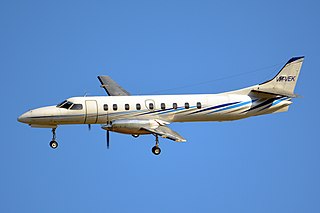
The Fairchild Swearingen Metroliner is a 19-seat, pressurized, twin-turboprop airliner first produced by Swearingen Aircraft and later by Fairchild Aircraft at a plant in San Antonio, Texas.
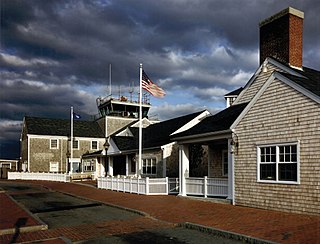
Nantucket Memorial Airport is a public airport on the south side of the island of Nantucket, Massachusetts, United States. It is owned by the Town of Nantucket and is located three miles (5 km) southeast of the town center. It is the second-busiest airport in the state, after Logan International Airport, due to intense corporate travel to and from the island in the high season.
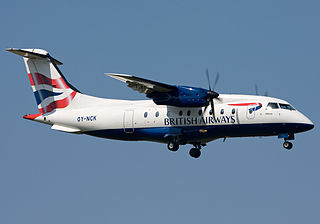
The Dornier 328 is a turboprop-powered regional airliner. Initially produced by Dornier Luftfahrt GmbH, the firm was acquired in 1996 by Fairchild Aircraft. The resulting firm, named Fairchild-Dornier, manufactured the 328 family in Oberpfaffenhofen, Germany, conducted sales from San Antonio, Texas, United States, and supported the product line from both locations. A jet-powered version of the aircraft, the Fairchild Dornier 328JET, was also produced.
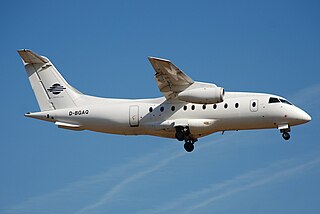
The Fairchild-Dornier 328JET is a commuter airliner, based upon the turboprop-powered Dornier 328, developed by the German aircraft manufacturer Dornier Luftfahrt GmbH. It would be the last Dornier-designed aircraft to reach production before the company's collapse during the early 2000s.

Peninsula Airways, operated as PenAir, was a U.S.-based regional airline headquartered in Anchorage, Alaska. It was Alaska's second-largest commuter airline operating scheduled passenger service, as well as charter and medevac services throughout the state. Its main base was Ted Stevens Anchorage International Airport. PenAir had a code sharing agreement in place with Alaska Airlines with its flights operated in the state of Alaska.
Corporate Express was an airline based at Calgary International Airport in Calgary, Alberta, Canada. The airline shut down operations on June 18, 2009.

Pel-Air Aviation Pty Ltd is an airline based in Mascot, Sydney, Australia.

The General Electric T700 and CT7 are a family of turboshaft and turboprop engines in the 1,500–3,000 shp (1,100–2,200 kW) class.
Wings West Airlines was an American regional airline headquartered at McChesney Field (SBP), unincorporated San Luis Obispo County, California. The airline initially began scheduled passenger service as an independent commuter air carrier and then subsequently became an American Eagle affiliate of American Airlines operating turboprop aircraft on code sharing flights on behalf of American.
SprintAir S.A. is a Polish airline headquartered in Warsaw and based at Warsaw Frederic Chopin Airport. It operates cargo services and passenger charter flights.
American Eagle is a brand name for the regional branch of American Airlines, under which six individual regional airlines operate short- and medium-haul feeder flights. Three of these airlines, Envoy Air, Piedmont Airlines, and PSA Airlines, are wholly owned subsidiaries of the American Airlines Group. American Eagle's largest hub is Charlotte Douglas International's Concourse E, which operates over 340 flights per day, making it the largest regional jet operation in the world.
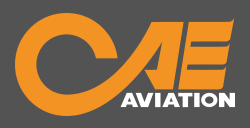
CAE Aviation is an aviation company based in Luxembourg providing services such as aerial surveillance, reconnaissance, parachuting and maintenance to various international governmental agencies and private operators. The business is unrelated to Canadian flight simulator manufacturer CAE.





















